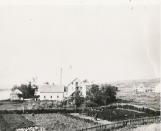14
The Hudson's Bay Company dock area at Peace River Crossing.Circa 1916-1930
Peace River Crossing, Alberta, Canada
 Credits:
Credits:Peace River Museum, Archives & Mackenzie Centre, 80.1150.001
15
Just over 100 kms upsteam from Peace River Crossing was Dunvegan, home to the Hudson's Bay Company and Revillon Freres (a Paris based trading company). This was a frequent stop for steamboats as freight and passengers could then travel overland to other centres such as Spirit River and Grande Prairie.16
Fort Dunvegan on the Peace River.Early 20th century, post 1909
Dunvegan, Alberta, Canada
 Credits:
Credits:Alberta Historic Sites, Reference Collection
17
Some 200 kms upstream from Dunvegan was the important centre of Fort St. John. This community was home to the Hudson's Bay Company as well as other businesses and provided access to a number of overland trails. Fort St. John was frequently the western end of steamboat voyages due to river conditions impeding further travel to Hudson's Hope.18
The S.S. Peace River docked at the landing at Fort St. John, British Columbia.June-July 1913
Fort St. John, British Columbia
 Credits:
Credits:University of Alberta Archives, Arthur Watts Fonds, UAA 76-50-14-157
19
Hudson's Hope was the most western point reachable by steamboats on the upper Peace River as the Peace River Canyon was just beyond.20
The S.S. D.A. Thomas near Hudson's Hope on the Peace River.Circa 1919
Hudson's Hope, British Columbia, Canada
 Credits:
Credits:Peace River Museum, Archives & Mackenzie Centre, 80.1123.18
21
in addition to these major stops on the upper Peace River steamboats often called in at other destinations for passengers and freight. This included such places as the St. Augustine Mission on the Shaftesbury Trail, and the NWMP Barracks near Peace River Crossing. There were several other spots where steamboats stopped to pick up wood.22
St. Augustine Mission.Circa 1928-1950
St. Augustine Oblate Mission, Shaftesbury Settlement, near Peace River, Alberta, Canada
 Credits:
Credits:Peace River Museum, Archives & Mackenzie Centre 75.656.017
23
The North West Mounted Police Barracks at Peace River Crossing.Early 20th Century
Peace River Crossing, Alberta, Canada
 Credits:
Credits:Peace River Museum, Archives and Mackenzie Centre
24
While the upper Peace River from Vermilion Chutes to Hudson's HOpe was basically navigable for steamboats it was not without challenges. Steamboats generally hired pilots to steer through the numerous islands and sand bars to be found on the river. Water levels varied considerably each year and an effort had to be made to watch for problems caused by this. In several years river traffic was stopped due to low water levels, especially near Hudson's Hope.25
The confluence of the Peace and Smoky Rivers.Circa 1930
Peace River Crossing, Alberta, Canada
 Credits:
Credits:Peace River Museum, Archives and Mackenzie Centre, x87.1521.57
26
In addition to natural obstacles to navigation steamboat crews had to be wary of man made structures. This included the cable ferries that crossed the river at Peace River Crossing and Dunvegan as well as the railway bridge at Peace River Crossing. As well, one had to watch for the numerouse rafts and barges used on the river.27
The ferry at Peace River Crossing.Circa 1911-1916
Peace River Crossing, Alberta, Canada
 Credits:
Credits:Peace River Museum, Archives and Mackenzie Centre, 80.1123.005